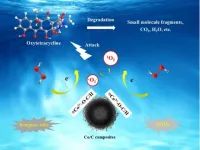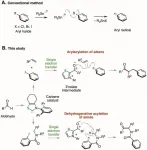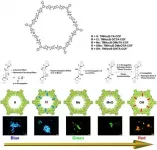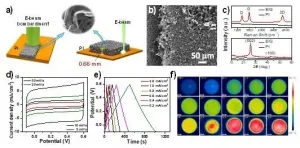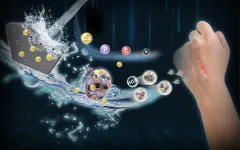Wallonia as an international reference for the timeline
Paleontologists from Univeristy of Liège (Belgium) redefine the geological boundary between the Devonian and Carboniferous periods. A Walloon site could be chosen as a world reference for this boundary.
2021-07-06
(Press-News.org) In 2016, researchers from the EDDyLab - Evolution & Diversity Dynamics Lab - at the University of Liège (Belgium) proposed a new definition of the geological boundary between the Devonian and Carboniferous periods (359 million years). This new definition has been tested by hundreds of researchers around the world and the results are now compiled in a special issue of the journal Palaeodiversity & Palaeoenvironments.
Geological time is divided into periods (Cambrian, Carboniferous, Jurassic, etc.), together covering the 4.6 billion year history of the Earth. The many climatic, environmental and biological changes that have punctuated this history are recorded in the rock layers, forming an incredibly rich archive of the Earth's past. "The study of these successive layers allows us to recognise the boundaries between these different periods, each boundary being defined by a specific event or 'marker', such as an extinction event or a change in climate," explains Julien Denayer, a palaeontologist at the EDDyLab and first author of the article. A locality is then designated, making the rocky successions of this particular place the international reference for this transition. "It was in Belgium, in the 19th century, that numerous divisions of the time scale were defined, such as the Frasnian, Tournaisian, Viséian, Namurian, etc... These references are still used today on an international scale.
The boundary between the so-called Devonian and Carboniferous geological periods (359 million years ago) was the first to be formally defined in 1927. The fossils marking the boundary were too rare in the rocks, so this definition was of little use. A second attempt was proposed fifty years later, but was also invalidated by the International Commission of Stratigraphy, the scientific body that establishes and validates the subdivision of geological time, again because of the scarcity of boundary fossils.
For the past ten years or so, palaeontologists and geologists specialising in the Devonian and Carboniferous periods have been working on redefining this boundary," says Cyrille Prestianni, palaeontologist at ULiège and co-author of the article. In 2016, we proposed a new definition, this time based on several contemporary phenomena, well recorded in the rocky successions of Wallonia. "According to the ULiège researchers, the boundary between these two periods is defined by the so-called Hangenberg Sandstone event - an episode of abrupt fall in sea level - which is also marked by a major extinction that decimated typical Devonian ecosystems such as coastal marshes and reefs. In ecological terms, this extinction was greater than the extinction of the dinosaurs at the end of the Cretaceous!
Since then, researchers around the world have tested the applicability of this criterion for defining the boundary. The results of these years of research are now compiled in a special volume of the journal Palaeodiversity & Palaeoenvironments. The EDDy Lab researchers publish an exhaustive review of the geological and palaeontological knowledge of the Devonian-Carboniferous boundary in Wallonia and the surrounding regions. In this publication, the members of the EDDy Lab were able to propose a scenario explaining the ecological and climatic crisis that caused the extinction of the Devonian fauna and flora. Our work is not yet finished," says Julien Denayer, "the next step is to select a new type locality. Several Walloon sites are now being studied using state-of-the-art techniques with a view to being proposed to become the world reference for the Devonian-Carboniferous boundary! »
INFORMATION:
[Attachments] See images for this press release:
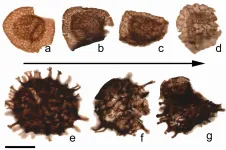
ELSE PRESS RELEASES FROM THIS DATE:
2021-07-06
Scientists from Tohoku University and the University of Maryland have pinpointed the strong magnetic field of the early sun as the reason behind the radial variation of rock and metal in rocky planets' cores. This magnetic field, which pulled small iron grains inward, explains Mercury's big iron core and why Mars has so little iron in its core.
The details of their research were published in the journal Progress in Earth and Planetary Science on July 5, 2021.
Planets have iron cores surrounded by a rocky shell, mostly made up of mantle and a thin skin of crust. The four inner planets of our Solar System, Mercury, Venus, Earth, and Mars have their own distinctive size and density. These ...
2021-07-06
Recently, a research team led by Prof. KONG Lingtao at the Hefei Institutes of Physical Science (HFIPS) of the Chinese Academy of Sciences (CAS) has prepared a type of hollow amorphous Co/C composites to activate hydrogen peroxide (H2O2) to generate singlet oxygen, achieving selective elimination of oxytetracycline (OTC) in complicated water matrices. The relevant results was published in Chemical Engineering Journal.
OTC is the most common tetracycline antibiotic in the field of animal husbandry. It can be detected in water, soil and other areas which features ...
2021-07-06
The study is the first on epidemiology and causes of traumatic brain injury in over 20 years. The research team reports in the journal BMJ Open of 4 June 2021.
Falling and cycling without a helmet are common causes
From a minor fall on a bicycle to a serious road traffic accident: The causes of a traumatic brain injury are manifold. About 90 percent of the approximately 270,000 cases per year are classified as mild, ten percent as moderate or severe. Current findings show that traumatic brain injury is increasing in the age group of over-65s. The research team at BG Kliniken in Bochum, Hamburg, Berlin, Halle, Frankfurt, Ludwigshafen and Murnau found that there has been a shift in the age group most frequently affected and ...
2021-07-06
[Background]
Aryl halides*1) with a benzene ring directly bonded to a halogen atom are readily available and chemically stable, so they are used as a source of benzene rings in organic synthesis. For example, a chemical reaction that generates a highly reactive aryl radical*2) from an aryl halide using a toxic tin compound has long been known as a method for supplying a benzene ring (Figure 1A). In recent years, chemical reactions have been developed, in which an aryl halide is reduced using a metal catalyst or a photocatalyst*3) followed by cleavage of the bond between the benzene ring and the halogen atom to generate ...
2021-07-06
Together with their multifaceted action mechanisms, activation-induced cytidine deaminase (AID) and so-called APOBEC proteins are important factors in the body's immune response and offer fast and effective protection against a large number of DNA and RNA viruses. The task of AID is to strengthen the human immune response, while APOBECs are able to block the virus. A MedUni Vienna research team comprising Anastasia Meshcheryakova, Diana Mechtcheriakova and Peter Pietschmann from the Institute of Pathophysiology and Allergy Research has now addressed the potential interrelations between AID/APOBECs and the SARS-CoV-2 virus, ...
2021-07-06
Ishikawa, Japan - Many researchers in the field of materials science constantly seek novel and versatile platforms that can be used to tailor materials to match their intended use. One example of this are covalent organic frameworks (COFs), an emerging class of crystalline porous polymers with a favorable set of fundamental properties, namely crystallinity, stability, and porosity. This combination makes them, in theory, adjustable to many modern applications. Unfortunately, owing to the way COFs are usually obtained, these properties are not very pronounced, resulting in unstable, low-crystallinity solids with limited porosity.
At the Japan Advanced Institute of ...
2021-07-06
Recently, Prof. WANG Zhenyang's research group from the Hefei Institutes of Physical Science (HFIPS) of the Chinese Academy of Sciences (CAS) has prepared macroscopic thick three-dimensional (3D) porous graphene films.
Using high-energy electron beam as the energy source and taking advantages of high kinetic energy and low reflection characteristics of e-beam, the researchers directly induced polyimide precursor into a 3D porous graphene crystal film with a thickness of up to 0.66 mm. Related research results were published in the journal Carbon.
Graphene has been proved ...
2021-07-06
A new nanotechnology development by an international research team led by Tel Aviv University researchers will make it possible to generate electric currents and voltage within the human body through the activation of various organs (mechanical force). The researchers explain that the development involves a new and very strong biological material, similar to collagen, which is non-toxic and causes no harm to the body's tissues. The researchers believe that this new nanotechnology has many potential applications in medicine, including harvesting clean energy to operate devices implanted ...
2021-07-06
Recently, with the help of a steady-state strong magnetic field experimental device, scientists constructed nano-scale borate bioactive glass (Nano-HCA@BG), which can effectively reduce the biological toxicity of borate bioglass, improve the biocompatibility of the glass, and promote the effect of borate bioglass on skin repair.
Prof. WANG Junfeng from the Hefei Institutes of Physical Science (HFIPS) of the Chinese Academy of Sciences (CAS), collaborating with Prof. ZHANG Teng from Fuzhou University in this study, said, "it is expected to become the next generation of skin wound repair dressings." Related research was published in Chemical Engineering Journal.
Borate bioglass is a glass with boron element (B) as the glass network matrix. With good dopability and degradability, it ...
2021-07-06
Sleep deprivation - from lifestyle choices, pandemic stress, or late-night computer study - can quickly lead to loss of energy and function during the day and even feelings of anger and depression, an Australian sleep institute study has shown.
The study, led by Flinders University, asked 34 health teenagers (20 males) aged between 15 and 17 to spent 10 days and nine nights in a specially designed sleep centre.
They were allocated to one of three sleep 'doses' for five consecutive nights- from five hours, 7.5 hours, or 10 hours in bed per night - with two baseline and two 'recovery' nights of up to 10 hours' time in bed.
Their mood was measured every three hours after waking up to assess responses to feelings such as 'depressed', 'afraid', 'angry', 'confused', ...
LAST 30 PRESS RELEASES:
[Press-News.org] Wallonia as an international reference for the timeline
Paleontologists from Univeristy of Liège (Belgium) redefine the geological boundary between the Devonian and Carboniferous periods. A Walloon site could be chosen as a world reference for this boundary.


